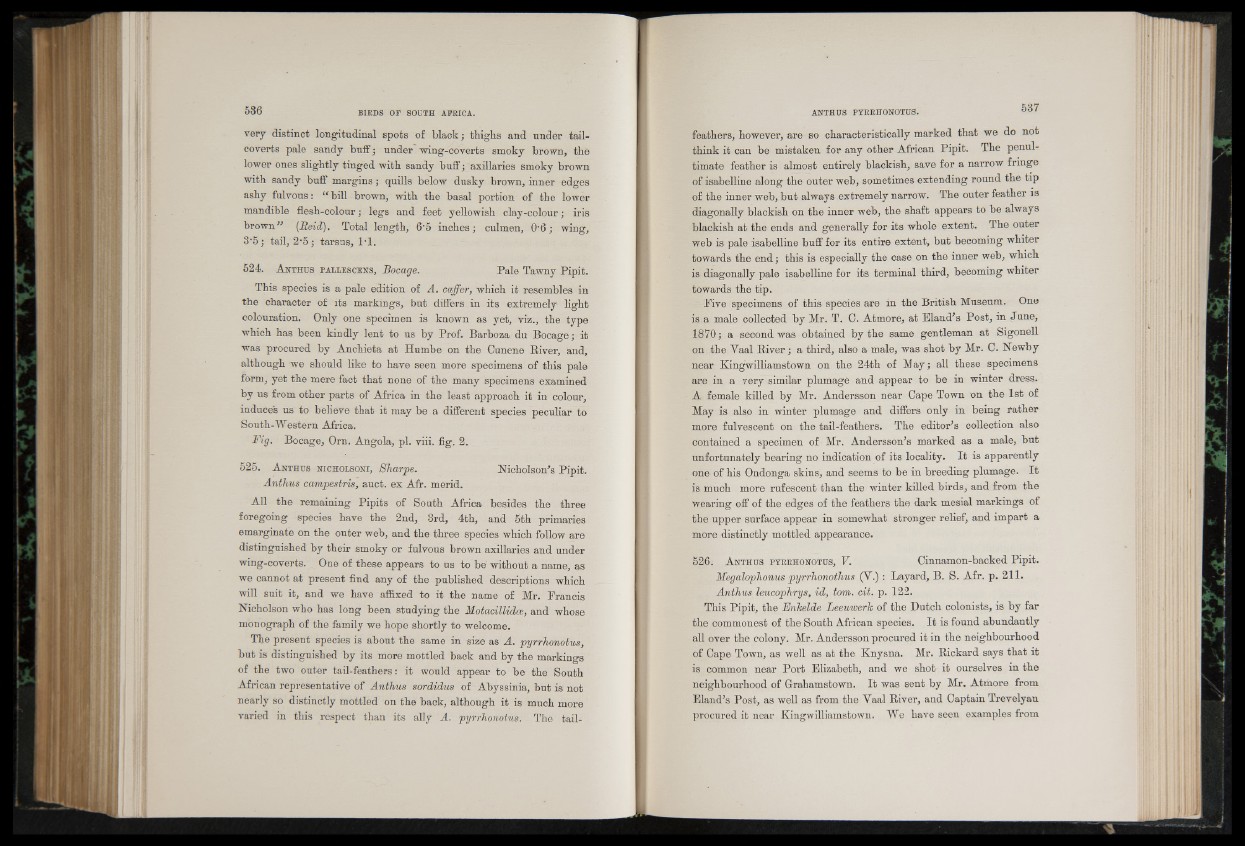
very distinct longitudinal spots of black; thighs and under tail-
coverts pale sandy buff; under wing-coverts smoky brown, the
lower ones slightly tinged with sandy buff; axillaries smoky brown
with sandy buff margins; quills below dusky brown, inner edges
ashy fulvous: “ bill brown, with the basal portion of the lower
mandible flesh-colour; legs and feet yellowish clay-colour; iris
brown” (Reid). Total length, 6-5 inches; culmen, 0’6 ; wing,
3'5; tail, 2'5; tarsus, Tl.
524. A n t h u s pal lescens , Bocage. Pale Tawny Pipit.
This species is a pale edition of A. caffer, which it resembles in
the character of its markings, but differs in its extremely light
colouration. Only one specimen is known as yet, viz., the type
which has been kindly lent to us by Prof. Barboza du Bocage; it
was procured by Anchieta at Humbe on the Cunene River, and,
although we should like to have seen more specimens of this pale
form, yet the mere fact that none of the many specimens examined
by us from other parts of Africa in the least approach it in colour,
induces us to believe that it may be a different species peculiar to
South-Western Africa.
Fig. Bocage, Orn. Angola, pi. viii. fig. 2.
525. A n th u s nicho lso ni, Sharpe. Nicholson’s Pipit.
Anthus campestris, auct. ex Afr. merid.
All the remaining Pipits of South Africa besides the three
foregoing species have the 2nd, 3rd, 4th, and 5th primaries
emarginate on the outer web, and the three species which follow are
distinguished by their smoky or fulvous brown axillaries and under
wing-coverts. One of these appears to us to be without a name, as
we cannot at present find any of the published descriptions which
will suit it, and we have affixed to it the name of Mr. Francis
Nicholson who has long been studying the Motacillidce, and whose
monograph of the family we hope shortly to welcome.
The present species is about the same in size as A. pyrrhonotus,
but is distinguished by its more mottled back and by the markings
of the two outer tail-feathers: it would appear to be the South
African representative of Anthus sordidus of Abyssinia, but is not
nearly so distinctly mottled on the back, although it is much more
varied in this respect than its ally A. pyrrhonotus. The tailfeathers,
however, are so characteristically marked that we do not
think it can be mistaken for any other African Pipit. The penultimate
feather is almost entirely blackish, save for a narrow fringe
of isabelline along the outer web, sometimes extending round the tip
of the inner web, but always extremely narrow. The outer feather is
diagonally blackish on the inner web, the shaft appears to be always
blackish at the ends and generally for its whole extent. The outer
web is pale isabelline buff for its entire extent, but becoming whiter
towards the end; this is especially the case on the inner web, which
is diagonally pale isabelline for its terminal third, becoming whiter
towards the tip.
Five specimens of this species are in the British Museum. One
is a male collected by Mr. T. 0. Atmore, at Bland’s Post, in June,
1870; a second was obtained by the same gentleman at Sigonell
on the Yaal River; a third, also a male, was shot by Mr. 0. Newby
near Kingwilliamstown on the 24th of May; all these specimens
are in a very similar plumage and appear to be in winter dress.
A female killed by Mr. Andersson near Cape Town on the 1st of
May is also in winter plumage and differs only in being rather
more fulvescent on the tail-feathers. The editor’s collection also
contained a specimen of Mr. Andersson’s marked as a male, but
unfortunately bearing no indication of its locality. It is apparently
one of his Ondonga skins, and seems to be in breeding plumage. It
is much more rufescent than the winter killed birds, and from the
wearing off of the edges of the feathers the dark mesial markings of
the upper surface appear in somewhat stronger relief, and impart a
more distinctly mottled appearance.
526. A n th u s pyrrhonotus, V. Cinnamon-backed Pipit.
Megalophonus pyrrhonothus (V.) : Layard, B. S. Afr. p. 211.
Anthus leucophrys, id, tom. cit. p. 122.
This Pipit, the Enkelde Leeuwerk of the Dutch colonists, is by far
the commonest of the South African species. It is found abundantly
all over the colony. Mr. Andersson procured it in the neighbourhood
of Cape Town, as well as at the Knysna. Mr. Rickard says that it
is common near Port Elizabeth, and we shot it ourselves in the
neighbourhood of Grahamstown. It was sent by Mr. Atmore from
Eland’s Post, as well as from the Yaal River, and Captain Trevelyan
procured it near Kingwilliamstown. We have seen examples from